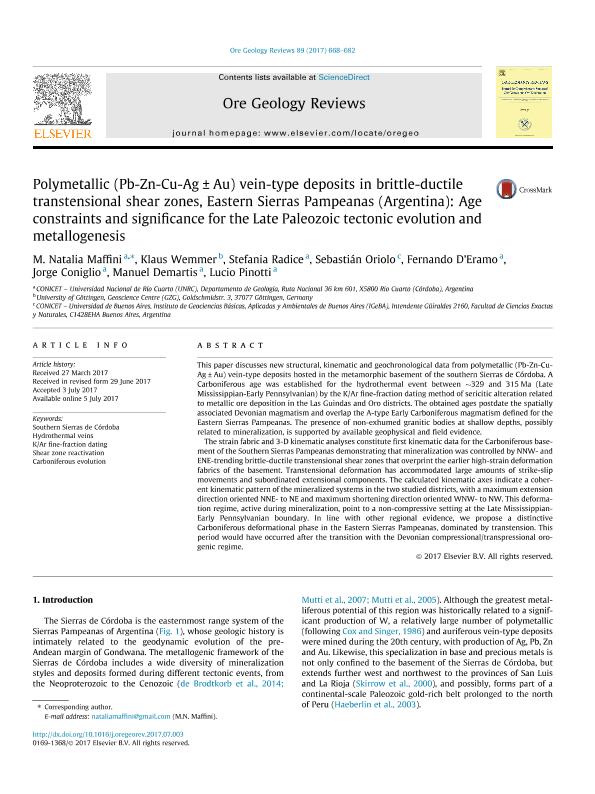Artículo
Polymetallic (Pb-Zn-Cu-Ag ± Au) vein-type deposits in brittle-ductile transtensional shear zones, Eastern Sierras Pampeanas (Argentina): Age constraints and significance for the Late Paleozoic tectonic evolution and metallogenesis
Maffini, María Natalia ; Wemmer, Klaus; Radice, Stefania
; Wemmer, Klaus; Radice, Stefania ; Oriolo, Sebastián
; Oriolo, Sebastián ; D'eramo, Fernando Javier
; D'eramo, Fernando Javier ; Coniglio, Jorge Enrique; Demartis, Manuel
; Coniglio, Jorge Enrique; Demartis, Manuel ; Pinotti, Lucio Pedro
; Pinotti, Lucio Pedro
 ; Wemmer, Klaus; Radice, Stefania
; Wemmer, Klaus; Radice, Stefania ; Oriolo, Sebastián
; Oriolo, Sebastián ; D'eramo, Fernando Javier
; D'eramo, Fernando Javier ; Coniglio, Jorge Enrique; Demartis, Manuel
; Coniglio, Jorge Enrique; Demartis, Manuel ; Pinotti, Lucio Pedro
; Pinotti, Lucio Pedro
Fecha de publicación:
10/2017
Editorial:
Elsevier Science
Revista:
Ore Geology Reviews
ISSN:
0169-1368
Idioma:
Inglés
Tipo de recurso:
Artículo publicado
Clasificación temática:
Resumen
This paper discusses new structural, kinematic and geochronological data from polymetallic (Pb-Zn-Cu-Ag ± Au) vein-type deposits hosted in the metamorphic basement of the southern Sierras de Córdoba. A Carboniferous age was established for the hydrothermal event between ∼329 and 315 Ma (Late Mississippian-Early Pennsylvanian) by the K/Ar fine-fraction dating method of sericitic alteration related to metallic ore deposition in the Las Guindas and Oro districts. The obtained ages postdate the spatially associated Devonian magmatism and overlap the A-type Early Carboniferous magmatism defined for the Eastern Sierras Pampeanas. The presence of non-exhumed granitic bodies at shallow depths, possibly related to mineralization, is supported by available geophysical and field evidence. The strain fabric and 3-D kinematic analyses constitute first kinematic data for the Carboniferous basement of the Southern Sierras Pampeanas demonstrating that mineralization was controlled by NNW- and ENE-trending brittle-ductile transtensional shear zones that overprint the earlier high-strain deformation fabrics of the basement. Transtensional deformation has accommodated large amounts of strike-slip movements and subordinated extensional components. The calculated kinematic axes indicate a coherent kinematic pattern of the mineralized systems in the two studied districts, with a maximum extension direction oriented NNE- to NE and maximum shortening direction oriented WNW- to NW. This deformation regime, active during mineralization, point to a non-compressive setting at the Late Mississippian-Early Pennsylvanian boundary. In line with other regional evidence, we propose a distinctive Carboniferous deformational phase in the Eastern Sierras Pampeanas, dominated by transtension. This period would have occurred after the transition with the Devonian compressional/transpressional orogenic regime.
Archivos asociados
Licencia
Identificadores
Colecciones
Articulos(CCT - CORDOBA)
Articulos de CTRO.CIENTIFICO TECNOL.CONICET - CORDOBA
Articulos de CTRO.CIENTIFICO TECNOL.CONICET - CORDOBA
Articulos(IGEBA)
Articulos de INSTITUTO DE GEOCIENCIAS BASICAS, APLICADAS Y AMBIENTALES DE BS. AS
Articulos de INSTITUTO DE GEOCIENCIAS BASICAS, APLICADAS Y AMBIENTALES DE BS. AS
Citación
Maffini, María Natalia; Wemmer, Klaus; Radice, Stefania; Oriolo, Sebastián; D'eramo, Fernando Javier; et al.; Polymetallic (Pb-Zn-Cu-Ag ± Au) vein-type deposits in brittle-ductile transtensional shear zones, Eastern Sierras Pampeanas (Argentina): Age constraints and significance for the Late Paleozoic tectonic evolution and metallogenesis; Elsevier Science; Ore Geology Reviews; 89; 10-2017; 668-682
Compartir
Altmétricas



